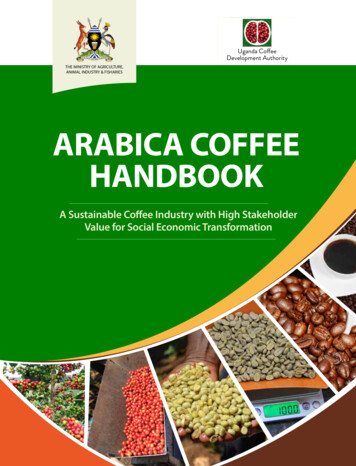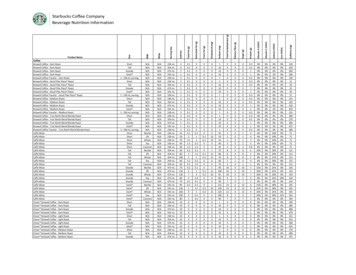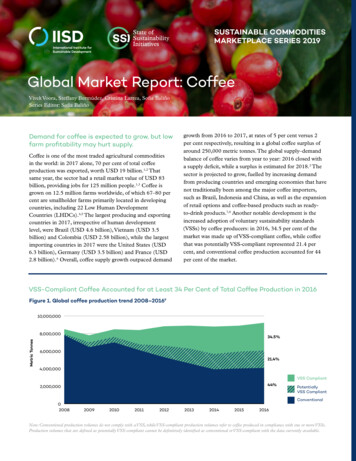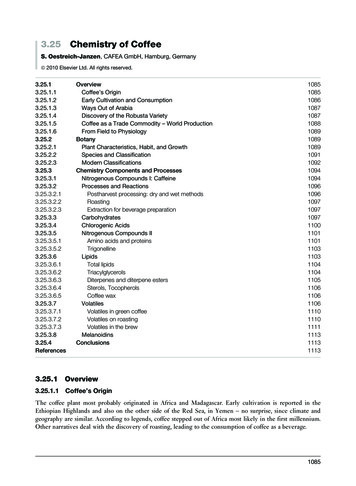
Transcription
Uganda CoffeeDevelopment AuthorityTHE MINISTRY OF AGRICULTURE,ANIMAL INDUSTRY & FISHARIESARABICA COFFEEHANDBOOKA Sustainable Coffee Industry with High StakeholderValue for Social Economic Transformation
2019: Uganda Coffee Development Authority (UCDA)Citation: Robusta Coffee Handbook. Uganda Coffee Development AuthorityUganda Coffee Development AuthorityCoffee House,Plot 35 Jinja Road,P. O.Box 7267, Kampala, UgandaTel: ( 256)-312-260470Email: info@ugandacoffee.go.ugWebsite: www. ugandacoffee.go.ugTwitter: @CoffeeUganda
TABLE OF CONTENTS1PREFACECHAPTER 1.1.01.11.21.31.41.5ARABICA COFFEE GROWING IN UGANDABackgroundGovernment policy and strategy for the coffee sub-sectorCharacteristics of Arabica Coffee and its importanceArabica Coffee growing zones in UgandaArabica Coffee varieties in UgandaObjectives of the Handbook3334446CHAPTER 2.ARABICA COFFEE AGRO-ECOLOGICAL REQUIREMENTS ANDPRODUCTION SYSTEMSIntroductionSoil requirementsAltitudeTemperatureRainfall and HumidityWind effectsArabica Coffee production systems2.6.1 Monocropping System2.6.2 Intercropping System92.02.12.22.32.42.52.6CHAPTER 3.3.03.13.23.33.43.53.63.73.8ARABICA COFFEE FARM ESTABLISHMENT AND FIELD MANAGEMENTPRACTICESIntroductionPlan the coffee farm layoutClear the sitePlant windbreakersMark out the rowsEstablishing shade trees3.5.1 Recommended shade tree species in coffee3.5.2 Tree species to avoid as shade trees for coffeeSet up water delivery systemsDig holesSelect good planting materials9999910101012151515151516171818202223
3.93.103.11Planting outWater the seedlingsArabica Coffee field management practices3.11.1 Weed control3.11.2 Nipping/capping of Arabica Coffee seedlings3.11.3 Mulching3.11.4 Water for Production and irrigation3.11.5 Soil and Water Conservation3.11.6 Use of Cover crops3.11.7 Pruning and De-suckering23242526262628323436CHAPTER 4.4.04.14.2REHABILITATION OF OLD ARABICA COFFEE FIELDSIntroductionRationale for rehabilitating old coffee treesCoffee Stumping practices4.2.1 Purpose of Coffee Stumping4.2.2 The stumping/cycle conversion procedureManagement of Coffee after Stumping4.3.1 Recommendations for 6-7 Year Coffee Pruning Cycle3939404040414445SOIL FERTILITY MANAGEMENT IN ARABICA COFFEE FARMINGIntroductionSoil analysisLeaf analysisCoffee Nutrition5.3.1 Benefits of fertilizing Arabica Coffee5.3.2 Importance of Macronutrients5.3.3 Visual nutrient deficiency identification5.3.4 Importance of MicronutrientsOrganic Fertilizers5.4.1 Crop residues5.4.2 Farmyard manure5.4.3 Compost5.4.4 Commercial organic fertilizersInorganic fertilizers5.5.1 Inorganic Fertilizer Blend for Coffee Trees up to 2 Years5.5.2 Inorganic Fertilizer Blend for Coffee Trees above 3 Years5.5.3 Foliar fertilizersManagement and effective use of fertilizer products5.6.1 Right fertilizer product5.6.2 Right fertilizer rate5.6.3 Right fertilizer 3CHAPTER 5.5.05.15.25.35.45.55.6
CHAPTER 6.6.06.16.26.36.46.56.66.76.85.6.4 Right fertilizer placement5.6.5 Nutrient antagonism and competition5.6.6 Soil nutrient availability and limitations to plant growth686969INSECT PESTS OF ARABICA COFFEE AND THEIR MANAGEMENTIntroductionYellow and White coffee stem borers6.1.1 Description6.1.2 Damage symptoms6.1.3 ControlAntestia bugs6.2.1 Description6.2.2 Damage symptoms6.2.3 ControlCoffee Berry Borer6.3.1 Description6.3.2 Damage symptoms6.3.3 ControlCoffee mealybugs6.4.1 Description6.4.2 Damage symptoms6.4.3 ControlCoffee lacebug6.5.1 Description6.5.2 Damage symptoms6.5.3 ControlCoffee leaf miner6.6.1 Description6.6.2 Damage symptoms6.6.3 ControlCoffee leaf skeletonizer6.7.1 Description6.7.2 Damage symptoms6.7.3 ControlTailed caterpilla6.8.1 Description6.8.2 Damage symptoms6.8.3 6767676767676767777777777
CHAPTER 7.7.07.1DISEASES OF ARABICA COFFEE AND THEIR MANAGEMENTIntroductionCoffee leaf rust7.1.1 Description7.1.2 Damage symptoms7.1.3 ControlCoffee berry disease7.2.1 Description7.2.2 Damage symptoms7.2.3 ControlRed blister disease7.3.1 Description7.3.2 Damage symptoms7.3.3 ControlRoot Rot or Collar Crack7.4.1 Description7.4.2 Damage symptoms7.4.3 ICA COFFEE HARVEST AND POST-HARVEST HANDLING PRACTICESIntroductionArabica Coffee harvesting best practicesWhy strip picking of coffee is not a recommended harvesting practiceArabica Coffee harvest seasonsArabica Coffee post-harvest handling and processing8.4.1 Wet Processing8.4.1 Dry ProcessingCoffee storage best practices838384858585858788CHAPTER 9.9.09.19.29.39.4ARABICA COFFEE VALUE ADDITIONIntroductionSorting dry parchment coffeeGrading of green coffee beansArabica Coffee grading and compliance safeguardsTransporting of green coffee beans9191919191957.27.37.4CHAPTER 8.8.08.18.28.38.4CHAPTER 10. COFFEE FARMING AS A BUSINESS10.0Introduction10.1Objectives of Coffee farming as a business10.2Types of coffee farming businesses10.2.1 Sole proprietor10.2.2 Partnership979797989898
10.710.810.910.2.3 Corporation10.2.4 CooperativesFarm records and accounts10.3.1 Farm Business Records10.3.2 Farm accountsProfitability indicators10.5.1 Gross margins10.5.2 Return on Investment10.5.3 Payback periodCoffee Marketing10.6.1 Scenario 1. Selling parchment coffee at local primary markets10.6.2 Scenario 3. Selling FAQ at national markets10.6.3 Scenario 4. Selling FAQ in Export MarketsAccess to FinanceEnterprise diversification to support coffee businessFamily decision-makingCHAPTER 11.11.011.111.211.311.4CLIMATE SMART ARABICA COFFEE PRODUCTIONIntroductionClimate change models and projections for coffee productionImplications of climate change for Arabica Coffee productionClimate change adaptation and mitigation strategies for Coffee growingStepwise climate smart investment pathways tools10.310.510.6CHAPTER 12. COFFEE SUSTAINABILITY FARMING PRACTICES12.0Introduction12.1Economic Sustainability12.2Social sustainability12.3Environmental sustainability12.4Certification programs and processes for Coffee farmers12.4.1 Organic Certification12.4.2 Fairtrade certification12.4.3 Rainforest Alliance certification12.4.4 Smithsonian Bird Friendly Certification12.4.5 4C Common trade certification12.4.6 Starbucks C.A.F.E. PracticesAnnexesAnnex 1: Healthy Benefits of CoffeeAnnex 2: Arabica Coffee Gross Margin per HectareAnnex 3: Coffee Farm 1122124125128
viARABICA COFFEE HANDBOOK
PREFACEUganda’s economy is agricultural-based accounting for 24% of GDP and employing over 70% of the population.Coffee is one of the leading commodities where about five million people are engaged in production and other coffeeassociated businesses. Among traded commodities, coffee is the largest contributor to exports, which for FinancialYear 2017/18 was valued at US 492 million, representing 16% of total exports. In terms of volumes, Uganda is 1stCommonwealth producer, 2nd African producer and 8th world producer. For Robusta production, it is the world’s 4thlargest producer.The market for coffee is assured, sustainable and the demand for good quality coffee is increasing. Currently, globaldemand for coffee stands at about 150 million bags against 148 million bags in exports, signifying a deficit of 3.3 millionbags. Demand is slated to rise to 175.8 million bags by 2020. Given the untapped production potential, Uganda has arare opportunity to benefit from increasing both the volume and quality of its coffee to supply this increasing demand.At household level, coffee is an important cash provider. With appropriate investment, farmers can earn incomes ofover Ushs 10 million per hectare per year. However, farmers must employ good agricultural practices such as plantinghigh yielding and disease resistant varieties, good field husbandry/management and post-harvest handling practices toimprove quality, productivity and value in the coffee farming system. To achieve these, coffee farmers and other valuechain actors need relevant, timely and accurate technical, market and other critical information to guide their operations.It has to be noted that Arabica Coffee has made significant progress in Uganda’s coffee production and exports, fromas low as 8.2% to the total coffee exports at the time of coffee sub-sector liberalization in 1991/92 to 14% 10 years laterand currently at 24.1% of total coffee exports. Conversely, in terms of value, Arabica Coffee has taken a similar stride,from 12% of the total foreign exchange to 23% ten years later and at 28% of total the total foreign exchange earned bythe country in 2017/18 Coffee Year.This handbook has therefore been prepared to guide Arabica Coffee farmers and other value chain players on bestcoffee production methods in respect to Good Agricultural Practices (GAPs) including soil nutrient management, pestsand disease management and control, harvesting and post-harvest handling, coffee farming as a business and coffeeregulations.Uganda Coffee Development Authority (UCDA) therefore strongly recommends this handbook to coffee farmers,extension staff, coffee buyers, processors, exporters and anybody with interest in coffee.We appreciate the efforts and resources of all those who contributed to the development of this handbook. In particular,United States Agency for International Development (USAID), Feed the Future Uganda, Enabling Environment forAgriculture Activity (EEA), for financial support and UCDA, Research and Academia Institutions, Coffee Associationsand other members of the working group for technical input.Dr. Emmanuel Iyamulemye NiyibigiraManaging DirectorUGANDA COFFEE DEVELOPMENT AUTHORITYARABICA COFFEE HANDBOOK1
ARABICA COFFEE GROWING IN UGANDA2ARABICA COFFEE HANDBOOK
CHAPTER 1ARABICA COFFEE GROWINGIN UGANDA1.0 BackgroundCoffee is the second most traded tropical commodityin value in the world after oil. Coffee is Uganda’smajor cash crop, both in terms of foreign exchangeearnings and employment creation. As a producer ofcoffee, Uganda ranks second in Africa after Ethiopiaand eighth in the world. Coffee as a commodity hascontinued to play a leading role in the economy ofUganda (contributing between 20 – 30% of theforeign exchange earnings), despite the vigorousefforts by government to diversify the economy.Coffee is grown by 1.7 million households in additionto the industry employing over 5 million peoplethrough coffee value chain related activities.centralized under the Ministry of Agriculture, AnimalIndustry and Fisheries (MAAIF) and offered throughUCDA’s coffee specific extension in collabourationwith other agencies such as National AgriculturalAdvisory Services (NAADS), Local Governments,coffee associations, private sector, NGOs, farmerorganizations/cooperatives and individual farmers.1.1 Government policy and strategyfor the coffee sub-sectorArabica Coffee production can be expanded/introduced in new areas of Uganda. Contributionof Arabica Coffee to Uganda’s export and foreignexchange earnings has increased from 8.2% in1991/1992 to 23% in 2017/2018 Coffee Year inquantity and 14% to 28% in US value respectively. Infulfillment of the Government’s policy and strategy,production is being boosted in old traditional ArabicaCoffee growing zones but also being encouragedin new areas. Rapid replacement of the old, lowproductive Arabica Coffee with high yielding, quickmaturing and disease tolerant improved varieties isencouraged. Farmers are being sensitized to grow thehigh yielding Arabica Coffee varieties, employ goodhusbandry practices and participate in marketingthrough their Farm Level Organizations (FLOs)or cooperatives to benefit from bargaining powerattained when marketing as a group.The coffee industry was liberalized in 1991 and,since then, anyone is free to engage in business atany level in the sub-sector, subject to conformingto the coffee regulations, 1994. Coffee research iscentralized and done under NARO through theNational Coffee Research Institute (NACORI) atKituza, Mukono District. Coffee extension is alsoThe coffee roadmap targets to increase in productionof quality coffee from the current figure of about 6million bags to 20 million bags, making Uganda oneof the top global producers. It targets to increaseyield by 3 to 4 times and expand production area by20% (5% in traditional areas and 25% in new areas).The roadmap also aims at expanding the middleIt is the country’s target to achieve lower middleincome status by 2040. To achieve this, the countrytargets an income level of about Ushs 20 million perhousehold. Arabica Coffee offers a good opportunityto contribute to the attainment of this target. Withgood investments and management, income fromone hectare of Arabica Coffee can reach about Ushs10 million and above per year.ARABICA COFFEE HANDBOOK3
ARABICA COFFEE GROWING IN UGANDAstratum of commercial farmers from the current10% to 65% while reducing smallholders from 85%to 25% by 2040. An enabling environment throughpublic-private partnership and collabouration is alsoenvisaged.In order to reap the economic benefits fromcoffee production and attain the Government’sgoal of middle-income status and vision 2040, it isrecommended that good agronomic and post-harvestpractices be applied by all categories of farmers,processors and traders. These include acquiringgood planting material, adopting proper husbandry,ensuring that good pest and disease control methodsare undertaken, carrying out good post-harvesthandling and engaging in coffee production as abusiness. This Arabica Coffee Production Handbookacts as a guide in all these aspects.1.2 Characteristics of Arabica Coffeeand its importanceArabica Coffee can grow up to 12m high in the wild;its leaves are dark green and oval or oblong. A brightred berry is produced which contains two seeds. Thefruits contain less caffeine than Robusta. ArabicaCoffee grows well in warm, temperate environments,usually at altitudes between 1,300 and 2,500 metres.The plants can grow to around 5 metres in height,although commercial plants are usually kept short.The leaves of the plant are dark green and it produceswhite flowers and deep red berries. Arabica Coffeefarmers pick the berries and remove the flesh, leavingonly the bean. The beans are then washed, driedbefore being sold. In Uganda the four recommendedand authorized Elite Arabica Coffee varieties are SL14, SL28, KP423 and KP162. Benefits of growingArabica Coffee include:4ARABICA COFFEE HANDBOOK Quality and price are rated much higher andis thus, more competitive on the internationalmarket because of its superior quality. Most gourmet/premium coffee is produced from100% Arabica beans. Can be well integrated with other crops on thefarm hence increasing returns to the farmer. It is a beverage with documented health benefits.1.3 Arabica Coffee growing zones inUgandaArabica Coffee is one of the two major types grownin Uganda and accounts for 20% of Uganda’s coffeevolume. It is grown in the highland areas on the slopesof Mount Elgon in the East, Mt. Rwenzori in theWest and Mt. Muhabura in the South Western Region,Okoro highlands in West Nile plus other highland areasat an altitude between 1,200-2,500m above sea level asshown in Figure 1. Arabica Coffee is an introducedcrop originating from Ethiopia. Arabica Coffee is morecompetitive on the international market because ofits superior quality and generally attracts better prices.Arabica Coffee is grown in 44 districts (51%), with 28(32%) growing only Arabica while 15 (17%) in Ugandagrow both Arabica and Robusta. Current productionstands at about 4.2 million bags, 80% of which is Robustaand 20% is Arabica whose average productivity is 0.3kgof clean coffee per tree per year.1.4 Arabica Coffee varieties inUgandaThe National Agricultural Research Organization(NARO) has improved upon and released 7 varietiesof coffee that are high yielding and resistant to coffeewilt disease. These varieties with their description,year of original release and major attributes arepresented in Table 1.
1950/60sBarboun. East Africanvarieties from MugugaQuarantine station. Releasedafter Scotts labouratorytesting for cup qualityBarboun. East Africanvarieties from MugugaQuarantine station. Releasedafter Scotts labouratorytesting for cup qualityKent. East African varietyKent. East African varietyIs a compact, high yielding1985variety developed in Kenyato allow for more intensivecoffee production with fewerlosses from diseases and pests.Dwarf variety with largebean size Grown by a smallnumber of small scalefarmers in Mt Elgon areaSL14SL28KP423KP162Variety RuiruIIVarietyCatimor 12919701950/60s1950/601950/60sYear ofreleaseArabicaDescriptionCoffee VarietyTable 1. Arabica Coffee varietiesYield up to 2,000kg/cc/ha/yr; Good cupquality; big beansYield up to 2,000kg/cc/ha/yr; Good cupquality; big beansYield up to 2,000kg/cc/ha/yr; Good cupquality; big beansYield up to 2,000kg/cc/ha/yr; Good cupquality; big beansMajor attributesGrown by a smallnumber of small scalefarmers in Mt ElgonareaRequires carefulmanagement tomaximize yield withoutoverbearingHigh yielding dwarfHigh yielding, dwarfhybrid grown by a small hybridnumber of small scalefarmers in Mt Elgon areaLimited distributiondue to highsusceptibility to leafrust and CBDContemporary varietyLimited distributiondue to highsusceptibility to leafrust and CBDContemporary varietyCurrent statusResistant to coffee leaf rustand coffee berry disease.Not popular among farmersdue to its’ high demand forfeeding and lightness of thebean/cherryTolerant to coffee leaf rustand resistant to coffee berrydiseaseVery susceptible to leaf rustand CBD. Not recommendedfor commercial cultivationVery susceptible to CBD butless susceptible to leaf rust.Recommended for mediumaltitudeVery susceptible to leaf rustand CBD. Not recommendedfor cultivationHighly susceptible to leafrust. Less susceptible toCBD than KP lines.Recommended for mediumto high altitude areasRemarksARABICA COFFEE GROWING IN UGANDAARABICA COFFEE HANDBOOK5
ARABICA COFFEE GROWING IN UGANDA1.5 Objectives of the HandbookCoffee is regarded as the most strategic commoditywhose development is being accelerated across thecountry to enable the sector to continue playing aleading role in wealth creation and fighting povertyat household level. To achieve this, it is criticalthat Ugandan farmers enhance their productionand productivity at farm level in a sustainable waythat addresses the social, ecological and economicdimensions. Government approved and launched anew National Coffee Policy 2013 and Strategy anda new National Agricultural Extension Policy in2017and Strategy. These policies rely in part on afunctioning public and private agricultural and coffee6ARABICA COFFEE HANDBOOKspecific, extension service. This handbook thereforeaims at achieving the following: Provide up-to-date technical resource to helpbuild the human resource capacity. Assist in building an efficient and effective publicand private extension service for Arabica Coffee. Increase awareness on the part of the generalpublic on benefits of growing Arabica Coffee. Facilitate the growth of Arabica Coffee enterprisesespecially at medium and large-scale levels in lightof the current coffee development strategy forpropelling the country into middle-income status.
ARABICA COFFEE GROWING IN UGANDAArabica Coffee Growing DistrictsSudanYumbe MoyoKobok.LegendArabica DistrictsRobusta DistrictsMrch.Both Arabica and RobustaAruaDistrict BoundariesLakesNational teraManafwaBugweri TororoBugiriMayugeBusiaNamayingoKalangalaBlmbl. KweenKpc.BukwoSirnk.Kibuku Budk. MbaleMpigiLwengo MasakaNakapiripirit Amdt.Kumi BukedeaIganga Namutmb. Butalj bimAmuriaKaberamaid oAmolatarWakisoBkmn. sanda ejuShem.MasindiKyegegwaIb umaniAmuru Gulu KaabongLamwoBuvumaKenyaLocation of Uganda in AfricaRakaiRubanda RukigaKabaleTa n z a n i aRwandaBurundi04590180 KilometersProduced by UCDA M&E DepartmentData Source: UCDA Seedling DatabaseShape File Source: UBOSMay 2019Figure 1. Map of Uganda showing the Arabica Coffee growing zonesARABICA COFFEE HANDBOOK7
ARABICA COFFEE AGRO-ECOLOGICAL REQUIREMENTS AND PRODUCTION SYSTEMS8ARABICA COFFEE HANDBOOK
CHAPTER 2ARABICA COFFEE AGRO-ECOLOGICALREQUIREMENTS AND PRODUCTION SYSTEMS2.0 IntroductionSome agro-ecological conditions are known toinfluence Arabica Coffee farming. These include soil,land, topography, amount and distribution of rainfall,altitude, temperature, humidity and wind effects.the inherent characteristics of acidity, aroma andbold bean can fully develop. Bold bean is classifiedas being between large and medium sized bean, withits width/length ratio bigger than that of a largebean.2.1 Soil requirements2.3 TemperatureArabica Coffee can grow on different soils types butdoes well on well-drained volcanic soils. For best rootestablishment, it requires a fertile, well aerated, freedraining, slightly acidic, deep soil with reasonablehumus content and a minimum depth of about 1mbefore roots reach an impermeable soil. ArabicaCoffee will not tolerate water logging or ‘wet feet’.The best or ideal soils are volcanic red earth or sandyloams with good structure and texture and rich inorganic matter. Avoid heavy clay or poor-drainingsoils, for good productivity. In addition, the soilshould be just slightly acidic, with a pH range of 5.5– 6.5 within which it would be well supplied with allthe essential major plant nutrients. Low or high pHwill limit crop performance.2.2 AltitudeAn elevation between 1,200m and 2,500m abovesea level is ideal for Arabica Coffee growing. Lowelevation Arabica Coffee does not possess the bestquality required by the world markets. Based on cuptests, areas within 1,500 to 2,500m clearly producesuperior quality/premium coffee. High elevationimproves the quality of the bean and potentialcupping quality. Due to a delay in ripening causedby cooler weather associated with higher altitudes,Since most Arabica growing areas in Uganda areabove 1,500m above sea level, the potential toproduce unique Arabica Coffee for specialty marketsis high. Arabica Coffee prefers a cool temperaturewith an optimum daily temperature range of 15 24 C (59 -75 F). Temperatures higher than 24 C(75 F) cause plant stress which leads to a cessation ofphotosynthesis. Mean temperatures of less than 15 C(59 F) also limit plant growth and are consideredsub-optimal. As Arabica Coffee is susceptible to frostdamage, use of shade trees to reduce the incidence isrecommended.2.4 Rainfall and HumidityArabica Coffee requires a rainfall range of 1,2001,800mm per annum, which is well distributed overa period of 9 months. Both the total amount andthe distribution pattern are important. Unless thereis regular rainfall, young newly planted coffee treesshould be irrigated (or hand watered if irrigation isnot available) atleast twice a week to ensure that thenewly planted seedlings get established. Also, if rainis inadequate during growth, supplemental watering/irrigation to induce uniform flowering and good fruitformation should be carried out. A fairly regular/frequent rainfall pattern throughout the berrydevelopment stage is required.ARABICA COFFEE HANDBOOK9
ARABICA COFFEE AGRO-ECOLOGICAL REQUIREMENTS AND PRODUCTION SYSTEMSA good soaking of 50mm every 10 days orapproximately 20 litre (1 jerrycans of water perplant per day) is required. Rainfall also triggersthe ripening process. Without adequate rainfall/moisture, flowering may extend over many monthsmaking plans for harvesting more difficult and otherfarm management practices unpredictable.Excessive droughts can cause the coffee tree tobecome dehydrated and thus lead to its defoliationand or increased attacks of plagues such as the redspider mite, leaf miner or the coffee berry borer.Excessive rainfall can, on the other hand, also affectthe flowering of the coffee tree by either diminishingit or destroying it altogether. Thus, locating coffeeplantings near a water supply for possible irrigationas well as for processing of cherry is desirable. Waterrequirements can also be reduced by use of suitable,well-established shade trees and mulch.2.5 Wind effectsHigh winds have an adverse effect on coffee growthbecause they can cause excessive evapotranspiration andincrease the demand for irrigation. Therefore, in windyareas, it is desirable to include windbreakers and shadetrees.2.6 Arabica Coffee productionsystemsThere are two types of Arabica Coffee growing i.e.monocropping (pure stand) and intercropping (mixedstand). Each system has its own advantages anddisadvantages.2.6.1 Monocropping SystemMonocropping is an agricultural practice of growingcoffee as a single crop or pure stand on one piece orplot of farmland as illustrated and shown in Figures2(a) and 2(b) respectively.The advantages and disadvantages ofmonocropping are highlighted in Table 2.Figure 2(a). An illustration of Arabica Coffee monocrop at a spacing of 8 x 8ft10ARABICA COFFEE HANDBOOKcoffee
ARABICA COFFEE AGRO-ECOLOGICAL REQUIREMENTS AND PRODUCTION SYSTEMSFigure 2(b). Arabica Coffee monocrop at a spacing of 8 x 8ftTable 2. Advantages and disadvantages of Arabica Coffee monocroppingAdvantages The coffee growing requirements, planting, maintenance including pest control and harvesting are conducted onthe same crop across the farmed land. This lower cost of production. It is much easier to cultivate one kind of crop, in terms of the knowledge and experience needed to do itsuccessfully. Requires less labour/not labour intensive.Disadvantages May lead to food insecurity. While increased coffee yields are campaigned for, need for food to feed thehouseholds is critical. Growing the same coffee crop year by year depletes valuable soil nutrients that plants rely on and hencethis deficiency must be compensated for by increasing amounts of fertilizers. High livelihood risk in case of crop failure.ARABICA COFFEE HANDBOOK11
ARABICA COFFEE AGRO-ECOLOGICAL REQUIREMENTS AND PRODUCTION SYSTEMS2.6.2 Intercropping SystemIntercropping also known, as mixed cropping or cocultivation is a type of farming that involves plantingcoffee plus one or more other different crops inthe same field. While the coffee is still young, thereis an area of land between the young coffee trees,which can be utilized to grow various crops, mainlyfood crops. Recommended intercrops for coffeein Uganda include bananas, non-climbing Phaseolusbeans, soya-beans, groundnuts and tomatoes.However, these must be confined to the central 2mof the inter-row, leaving a clear 0.5m between themand the coffee tree.Two crops can be grown per year during the first twoyears but it important to note however, that growingbeans on the same plots, particularly in the humidareas, may result in serious problems of aphids.This practice therefore, should be avoided. Maize,cassava and potatoes are high nutrient demand cropsand are therefore not recommended. The coffee-banana intercropping, as illustrated and shown inFigures 3(a) and 3(b) respectively, is a major typeof coffee system in Uganda that is encouraged.During the phase of early establishment, bananas,which are a permanent crop commonly grown withcoffee, may be established. The banana will provideshade for the young coffee in the early years whileat later years the fallen banana leaves proved mulchcover and manure for coffee. However, if plantedin large numbers, bananas may compete with coffeeplants for nutrients. For this reason, a banana/coffeeratio of 1:4 is recommended until results of ongoing research are validated. In this combination,each banana plant would shade four coffee bushesand each coffee bush would be shaded by only onebanana plant. The advantages and disadvantages ofcoffee-banana intercrop are highlighted in Table 3.In banana Arabica Coffee intercrop, establish properspacing for both banana and coffee. Spacing of 8ft x8ft. (Coffee) and 16ft x 16ft. (Banana) is appropriate.Figure 3(a). An illustration of Coffee-Banana intercrop at a spacing of 8 x 8ft12ARABICA COFFEE HANDBOOK
ARABICA COFFEE AGRO-ECOLOGICAL REQUIREMENTS AND PRODUCTION SYSTEMSFigure 3(b). Coffee-Banana intercrop spaced at 8ft x 8ftTable 3. Advantages and disadvantages of the coffee-banana intercrop systemAdvantages Growing bananas in a young coffee field ensures that the farmer gets some return from the land before thecoffee reaches the productive stage. Intercropping banana and coffee reduces the income risk faced by farmers who cultivate a monocrop. Return to labour is often higher in banana–coffee systems. It increases total revenue/inflow per unit area byabout 30% compared to coffee monocropping. Improves coffee quality. In addition it provides food to the household. Increases yields by intensifying crop management of both bananas and coffee. The banana provides shade for coffee, which reduces stress caused by extreme temperatures and strong winds. The banana crop residues provide mulch that improves soil fertility due to the large biomass turnover fromrotting banana leaves. The permanent canopy and root systems of banana reduce soil erosion by reducing the impact of rainfall on thetopsoil and reduced run-off. Reduces greenhouse gas (GHG) emissions by increasing carbon stocks from both banana and coffee.Disadvantages It increases competition for water, nutrients and light. It is labour intensive and requires a lot of management and care. If shade is too dense, the yield potential of coffe
TABLE OF CONTENTS PREFACE 1 CHAPTER 1. ARABICA COFFEE GROWING IN UGANDA 3 1.0 Background 3 1.1 Government policy and strategy for the coffee sub-sector 3 1.2 Characteristics of Arabica Coffee and its importance 4 1.3 Arabica Coffee growing zones in Uganda 4 1.4 Arabica Coffee







![[Ringle Material] 3rd wave coffee (Philz Coffee and Blue .](/img/22/2592b1ca.jpg)


